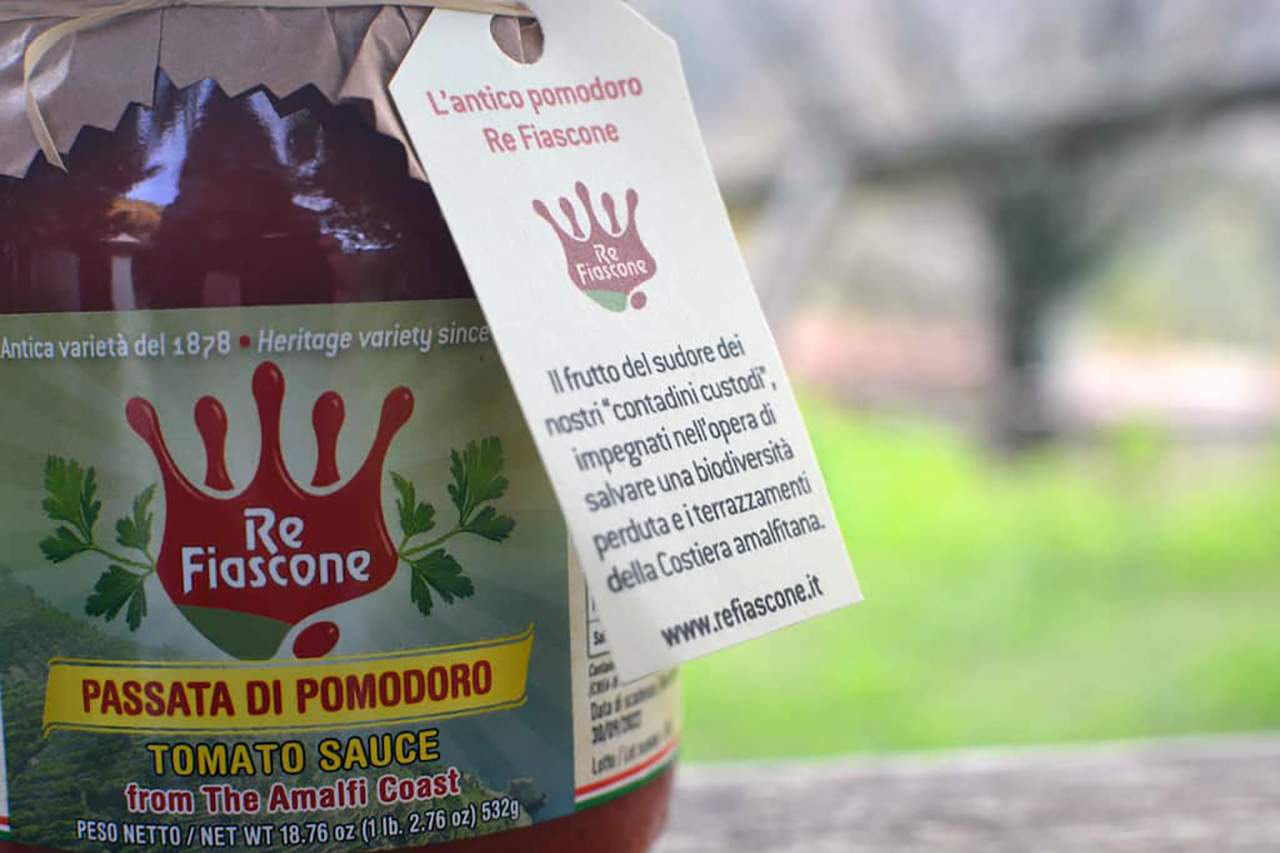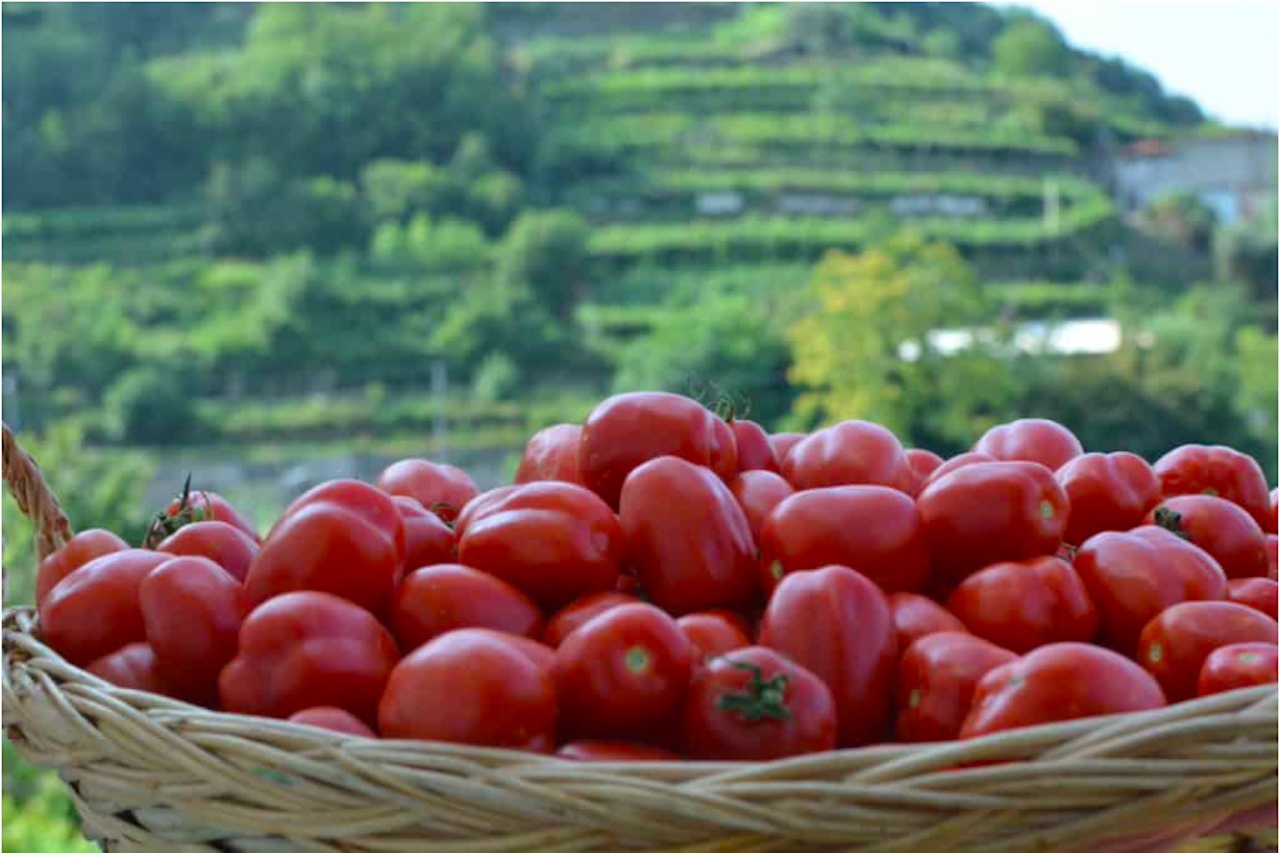Stories of a fearless type of agriculture and social inclusion on the Amalfi Coast
January 15th, 2021. By Annamaria Parlato
The first time the tomato ever appeared in a herbarium was in 1636. Still, it wasn’t classified scientifically as a fruit until 1743 when Carl Linnaeus placed it in the genus Solanum, Solanum Lycopersicum (meaning wolf’s peach in Ancient Latin).
In 1768, Philip Miller decided to change it, believing that the tomato was far too different from the other genus Solanum plants; this is how the new scientific name of Lycopersicon esculentum was born. Regarding how this plant grows, in the beginning, it tended to expand on the ground, outspreading. Still, it is now cultivated vertically and collected thanks to modern agricultural techniques.
Back to the origin
The origin of the tomato seems to indicate South America, specifically Mexico, Ecuador, and Perù, so it’s no surprise that this berry proliferates in a country like Italy with a similar warm-temperate climate. Could we ever think about the legendary dishes from Mediterranean cuisine (pizza, salads, and sauces) without picturing one of the world’s most famous vegetables?
Historically, we don’t know how and when these plants arrived in Seville, but it is common to believe that it was possible thanks to Colombo’s or Cortés’ ships. Among the things they took home with them, there probably were also tomatoes and wild tomato plants. Although it was believed to be toxic initially, this yellowish-red-looking berry began to spread slowly during the 17th century, especially in the lower population’s kitchens. And then, the tomato finally arrived in Naples thanks to the geographical and political proximity to Spain and found a perfect climate to be harvested.
Around this time (18th century), Mediterranean farmers thought about possibly using the berry for cooking. In 1839 tomatoes appeared in Ippolito Cavalcanti’s cookbook, where he described in the Neapolitan dialect the recipe for “vermicelli con le pommadore” (a type of pasta with tomatoes). During this time, tomatoes and pizza were first mixed, even if it was still a prerogative south of the country. Italian families would have to wait until the industrial production of the early 1900s to have a bottle of tomato sauce to use directly in their kitchen.
History and characteristics of Fiascone
King Umberto, the famous variety of tomato, also called Fiascone locally, has been harvested since the beginning of the 20th century in Tramonti and its land. The name is in honor of King Umberto I of Savoia, who was King of Italy since 1878, and it was chosen to indicate a variety of tomatoes that were so good to be worthy of a king.

From harvest to the preservation
This type of tomato has been at risk of extinction, but thanks to local farmers and families’ constant attention and efforts, we can still enjoy it today. Fiascone has always been an essential feature in local people’s houses: harvesting tomatoes during the summer has always been present to create a handmade sauce that families could use for their dishes all year.
This tomato is the perfect addition to salads when consumed raw but works well for the industrial transformation in sauce; it is also important to highlight that it was discovered to be San Marzano’s ancestor, one of the best-selling tomatoes in Italy.
Between the end of the 19th and 20th centuries, the tomato appeared in some catalogs of Ingegnoli and Sgaravatti. Ense, a national seeds organization that no longer exists, banned King Umberto from the official registry of tomato varieties. For this reason, we couldn’t keep track of the vegetable.
The process
Usually, around the beginning of March, the seeds get planted into professional seedbeds to protect the seedlings from wild animals. At the start of May, when plants still need help growing, chestnut strakes and river canes are added as a support along the trunk.
To cultivate King Umberto’s variety, local farmers only use handheld equipment since the Amalfi Coast terraced fields cannot support heavy machinery; this is why people often refer to this kind of crop as “fearless agriculture.” But even if the work itself is arduous, this kind of tomato helped recover wild and abandoned fields that are productive and fertile today.
The work of Acarbio and Crea Ort of Pontecagnano
ACARBIO (Associazione Costiera Amalfitana Riserva Biosfera) is an essential non-profit association led by its President, Vincenzo Sannino that conducted a study on the King Umberto seeds in 2016. They found out that some local farmers still kept the seeds of the Fiascone when it was believed to be extinct: they didn’t have too many of them, but it was enough to create a little nursery.
They then launched a crowdfunding project intending to revive the enthusiasm towards this precious vegetable. Thanks to the critical contribution of Rosa Pepe from the CREA-ORT (center for horticultor research) in Pontecagnano and of the Comitato Promotore dei Distretti Rurali (a rural district that promotes committee), the project became a reality. They brought farmers together, gave them the seeds, and began to follow the cropping process closely. Again, it is essential to mention that it was possible to restart agricultural production thanks to those local seed savers farmers.
The result of this process is a high-quality product. Vincenzo Sannino explains, “It’s all about attention, passion, and effort in every phase, starting from the seeds to the labeling. Everything is essential in handling perfectly the red gold that grows in our land. But none of this would have been possible without the farmers and partners like Antonio Di Martino and Crea-Ort that believed in this idea. Regarding new activities, I can say that the project to recover terraces is still going strong and that 2020 was a perfect season for us. Fiascone is listed among the typical local products, and the town of Tramonti even gave to the tomato its designation of origin“. “Re Fiascone” aims to help boost the local economy and farmers and protect the terraced landscape.

International accomplishments
The ACARBIO pilot project has been entrusted to a local cooperative to help it grow. In the meantime, it has also brought to life a new startup called Effetto Costiera. “We won first place out of 25 finalists in the Clic Start-up Competition,” says Sannino.
The Institute for Research on Innovation and Services for Development (IRISS), a scientific organ of the National Research Council (CNR), awarded their project Taste of Terraces a prize of 3000 euros. They weren’t the only ones to recognize its value. The startup also won a prize awarded by the ICHEC Brussels Management School inside the C-Ship program and by the Enea EEN to make the project global.
“It is sad that ideas like ours are rarely supported locally. Thanks to international pizza chefs working in chains such as N900 (Canada), we could keep going. It’s important not to undersell these tomatoes, contrary to what happens in other environments. We are proud that Re Fiascone made it possible for the younger generations to approach agriculture and even helped more than ten families find jobs“.
The approach to this project has always been about production sustainability following the circular economy. Bio-economy and innovation, and it is safe to say that these were the winning cards along with the essential contribution of Crea Ort. «In 2012, during a congress on the Montoro’s onion, I was approached by Vincenzo and Maria Rosario Sannino from the ACARBIO association. They wanted my opinion on Fiascone and if their seeds had potential, » says Ms. Rosa Pepe.
For three years, the first plants from those special seeds started to be investigated by the Research Institution and the University of Fisciano. “I’m sure we will continue studying the molecular entity of the seeds so that we can deepen our knowledge on the correlation that this tomato has with other varieties (San Marzano, Fiaschello of Battipaglia). The important thing is that we could trace back the place of origin of this berry to the terraced fields of Tramonti that were abandoned a long time ago for the lack of use in agriculture“.
The Campagna region’s identity
Now King Umberto has its place on the market and has been added to the regenerative supply chain of La Cesta Della Biodiversità. “We hope that Fiascone could be the example that it is possible to invest in the biodiversity that comes from our land. The synergy among all the partners was vital for this project’s success, especially the work done by Ms. Maria Rosaria Sannino, professional journalist and President of the Club Unesco Amalfi“.

